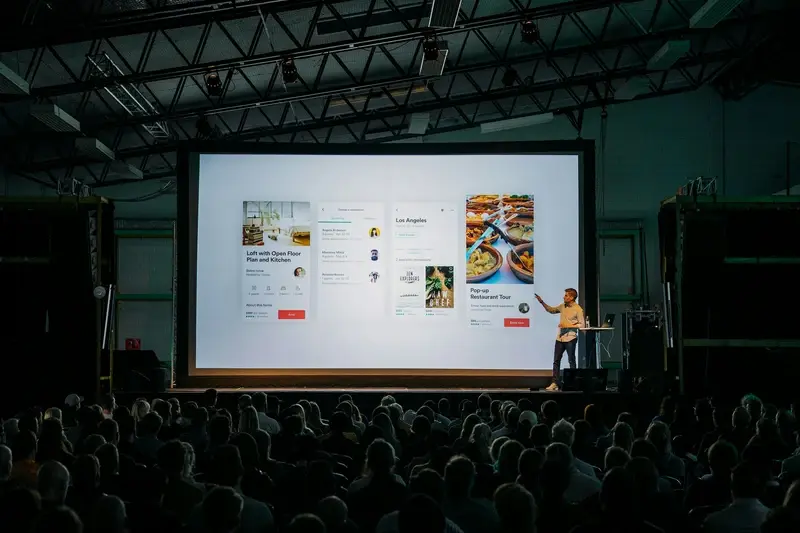What Should I Include in My App Investment Pitch Deck?
Most app ideas never see a penny of investment funding—not because they're bad ideas, but because their creators couldn't communicate the opportunity clearly enough. After eight years of building apps and helping clients secure funding, I've sat through countless pitch presentations. Some were brilliant concepts that fell flat in the room; others were mediocre ideas that somehow secured millions. The difference? How well they told their story.
Building a great app is only half the battle. If you want investors to back your mobile app idea, you need more than just passion and a decent prototype—you need a pitch deck that speaks their language. And honestly, most people get this completely wrong. They focus too much on features and not enough on the business opportunity. They ramble about technical specs when they should be talking about market size and revenue potential.
The best app pitch decks don't just show what you're building—they prove why it matters and how you'll make money from it
I've helped dozens of clients refine their app funding presentations, from solo founders trying to raise their first £50k to established companies seeking series A rounds worth millions. What I've learned is that successful app pitch decks follow a specific structure—one that addresses investors' core concerns while building excitement about your vision. Whether you're pitching to angel investors, VCs, or potential business partners, getting your presentation right can mean the difference between securing the funding you need and watching competitors beat you to market. Let me show you exactly what needs to go in your app investment pitch deck.
Understanding Your Audience and Goals
Right, let's get one thing straight from the start—if you don't know who you're pitching to, you're already setting yourself up for failure. I've seen brilliant app ideas crash and burn because the founder walked into a room full of healthcare investors and started talking about their gaming app's social features. It's honestly painful to watch.
Before you even open PowerPoint (or whatever you use), spend some proper time researching who's going to be sitting across from you. Are they early-stage VCs who get excited about user growth metrics? Are they corporate investors looking for apps that solve specific business problems? Or maybe they're angel investors who've built and sold apps themselves? Each group cares about completely different things.
Know Your Investor Type
VCs want to see massive market potential and scalability—they're thinking about 10x returns. Corporate investors? They're often looking for strategic value, like how your app might complement their existing products or help them reach new customers. Angel investors usually focus on the team and early traction because they've been in your shoes.
Once you know your audience, you need to be crystal clear about what you're asking for. Don't just say "we need funding"—that tells them nothing. Are you raising £250k to build your MVP and validate the market? Or are you looking for £2m to scale an app that's already gaining users? Your goals should match your stage, and your pitch should reflect that. If you're pre-launch asking for scaling money, investors will smell the disconnect immediately.
The key thing is matching your story to what matters most to the people writing the cheques. Get this bit wrong and the rest of your pitch deck won't matter.
The Problem and Market Opportunity
Right, let's talk about the meat of your app pitch deck—the problem you're solving. I can't tell you how many founders come to me with an app idea but struggle to articulate the actual problem its addressing. And honestly? If you can't explain the problem clearly, investors are going to switch off faster than you can say "disruptive innovation."
Start with the pain point. What specific frustration, inefficiency, or gap exists in people's lives that your app tackles? I always tell clients to think about problems they've personally experienced—those "bloody hell, there has to be a better way to do this" moments. The best mobile apps solve real problems that people are already trying to solve, just not very well.
Sizing Up Your Market
Once you've nailed the problem, you need to show there's a big enough market willing to pay for your solution. This is where a lot of app pitch decks fall flat; they throw around massive numbers like "the mobile app market is worth £100 billion" without getting specific about their slice of it.
Break your market down into three layers: the total addressable market (how big is the overall space?), your serviceable addressable market (what portion can you realistically reach?), and your serviceable obtainable market (what you can capture in the next few years). Be realistic here—investors can smell inflated projections from a mile away.
Timing Is Everything
You also need to explain why now is the right time for your app. What's changed recently? New technology? Shifting user behaviours? Regulatory changes? The most successful apps I've built have ridden some kind of wave—whether that was the rise of smartphones, changes in privacy laws, or shifts in how people work and socialise.
Use real data from credible sources when sizing your market. Avoid generic industry reports—dig into specific user research, surveys, or behaviour studies that support your assumptions about demand.
Your App Solution and Product Demo
Right, this is where things get exciting—and where most people either nail it or completely mess it up! Your app solution slide is basically your moment to shine, but I see founders make the same mistakes over and over again. They either show too much detail (boring the investors to tears) or they're so vague that nobody understands what the app actually does.
Here's the thing: investors want to see your app in action, not just hear about it. A product demo is worth a thousand bullet points, trust me on this one. But—and this is important—keep it focused on solving the problem you just outlined. Don't show every single feature you've built; show the core functionality that addresses your users' main pain point.
What to Include in Your Solution Section
Your solution needs to be crystal clear and directly connected to the problem. I always tell my clients to follow this simple structure:
- What your app does in one clear sentence
- Key features that solve the core problem
- What makes your approach different
- Brief demo of the main user journey
- Any early traction or validation you've got
The demo part is where you really need to think like a user, not a developer. Show the happy path—the smoothest possible experience from opening the app to completing the main task. Keep it under two minutes, focus on the value proposition, and for goodness sake, make sure it actually works when you're presenting!
One more thing: if your app isn't built yet, mockups and wireframes are fine, but be honest about what stage you're at. Investors can smell fake demos from a mile away, and it destroys credibility faster than you can say "minimum viable product."
Business Model and Revenue Strategy
Right, let's talk money—because that's what investors really want to understand. Your business model isn't just about how you'll make revenue; its about proving your app can become a sustainable, profitable business that actually makes sense in the real world.
I've seen too many pitch decks that treat monetisation as an afterthought. "We'll figure out the money later" doesn't cut it anymore. Investors want to see you've thought deeply about how users will pay for your app, when they'll pay, and why they'll keep paying. The most successful apps I've worked on had their revenue model baked into the user experience from day one, not bolted on afterwards.
Revenue Models That Actually Work
Freemium works brilliantly for apps that can demonstrate clear value quickly then offer premium features users genuinely need. Subscription models are fantastic if you're providing ongoing value—think fitness apps with new workouts weekly or productivity tools that sync across devices. One-time purchases still work for utility apps, but you need a solid plan for user acquisition since there's no recurring revenue.
The best revenue models feel invisible to users because they align perfectly with how people naturally want to use the app
Don't just throw numbers at investors without context. Show them your unit economics—how much it costs to acquire a user versus their lifetime value. If you're spending £5 to acquire users who generate £20 over six months, that's a story investors understand. Include your assumptions about conversion rates, churn, and growth; even if they're estimates, it shows you're thinking like a business owner, not just an app creator.
Market Analysis and Competition
Right, let's talk about the bit that makes most founders uncomfortable—proving you actually understand your market and aren't just guessing about who your competitors are. I've sat through countless pitch meetings where someone says "we don't really have any direct competitors" and honestly? That's a massive red flag for investors.
Your market analysis needs to show you've done your homework. Start with the size of your addressable market, but don't just throw around massive numbers like "the mobile app market is worth £100 billion." Break it down into your specific niche. If you're building a fitness app for new mums, what's that market worth? How many new mums are there each year who'd actually pay for this?
Competitive Landscape
Now here's where it gets interesting—your competition analysis. Sure, list the obvious direct competitors, but also think about indirect ones. That fitness app? It's not just competing with other fitness apps; it's competing with YouTube workout videos, local gyms, and even Netflix when someone's deciding how to spend their evening.
For each main competitor, show what they do well and where they fall short. This isn't about slagging them off—it's about demonstrating you understand the market gaps you can fill.
| Competitor | Strengths | Weaknesses | Your Advantage |
|---|---|---|---|
| Main Competitor A | Large user base | Poor user experience | Better design, faster performance |
| Main Competitor B | Good features | Expensive pricing | More affordable model |
The key is showing investors you're not delusional about the competition—you know exactly what you're up against and have a realistic plan to compete. That's what builds confidence in your ability to execute.
Technology and Development Approach
When it comes to the tech side of your app pitch deck, investors want to know you're not just another dreamer with a fancy idea. They need to see that you understand the technical challenges ahead and have a solid plan to overcome them. I've seen too many promising pitches fall apart because the founders couldn't explain how they'd actually build their app—or worse, they'd wildly underestimated the complexity involved.
Start by explaining your development approach clearly. Are you building native iOS and Android apps, or going cross-platform with React Native or Flutter? There's no right answer here, but there is a right explanation. If you're targeting both platforms simultaneously with a limited budget, cross-platform makes sense. But if you need platform-specific features or maximum performance, native development might be worth the extra cost.
Don't get too technical in your pitch deck. Investors care more about your timeline, scalability plans, and risk mitigation than your choice of database architecture.
Key Technical Considerations to Address
Your technology section should cover the main technical decisions without drowning investors in jargon. Focus on the choices that impact your business directly—development timeline, ongoing costs, and ability to scale. If your app needs to handle millions of users eventually, explain how your architecture supports that growth.
- Development platform choice (native vs cross-platform)
- Backend infrastructure and scalability plans
- Security measures and data protection approach
- Third-party integrations and API dependencies
- Development timeline and milestone breakdown
Be honest about technical risks too. Every app project has them, and investors know this. If you're integrating with complex payment systems or handling sensitive health data, acknowledge the challenges and explain how you'll manage them. This shows maturity and builds confidence in your ability to deliver.
Team and Expertise
Let me be honest with you—investors don't just fund apps, they fund people. I've seen brilliant app ideas fail because the team couldn't execute, and I've watched average concepts succeed because they had the right people behind them. Your team slide isn't just a list of names and titles; its your chance to prove you can actually build what you're promising.
Start with your core team members and focus on what makes each person the right fit for this specific project. Don't just say "John has 10 years of experience"—explain why Johns particular experience matters for your app. If you're building a fintech app and your CTO has worked at three different banks, that's gold. If your designer previously worked on award-winning healthcare apps and you're building a medical platform, mention that.
What Investors Actually Want to See
Here's what I tell my clients to include for each key team member:
- Relevant experience that directly relates to your app's industry or technology
- Previous successful projects or exits (even if they were smaller ventures)
- Technical skills that match your development requirements
- Leadership experience if they'll be managing other team members
- Any industry connections or domain expertise that gives you an advantage
But here's the thing—don't oversell it. If you're a first-time founder, own it. Investors would rather see honesty about your experience level combined with a clear plan for filling skill gaps than watch you pretend to be something you're not. I've worked with plenty of successful first-time founders who were upfront about their limitations and had a solid plan for bringing in advisors or senior hires.
Addressing the Gaps
Every team has gaps, especially in the early stages. Maybe you're a technical founder who needs business expertise, or you've got the business side covered but need development help. Address these gaps head-on. Show that you understand what's missing and have a plan to fill those roles.
Financial Projections and Funding Requirements
Right, let's talk money—because at the end of the day, that's what investors really want to understand. I've seen countless pitch decks where founders get so excited about their app features that they rush through the financials or, worse, make them look completely unrealistic. Big mistake.
Your financial projections need to tell a story that makes sense. I mean, if you're projecting a million users in year one when you haven't even launched yet, investors will see right through that. Start with your revenue model—whether that's subscriptions, in-app purchases, advertising, or a combination. Then work backwards from realistic user acquisition numbers.
Building Credible Revenue Forecasts
Here's what I always tell clients: base your projections on real data wherever possible. Look at similar apps in your space, their pricing models, typical conversion rates from free to paid users. The industry average for freemium apps is usually around 2-5% conversion rate, so don't assume you'll magically hit 20%.
Break down your costs too—development, marketing, staff, app store fees, hosting. Investors want to see you understand the full picture of what it takes to run an app business. And be honest about your funding requirements; asking for too little shows you don't understand your market, asking for too much makes you look greedy.
The most convincing financial projections aren't the most optimistic ones—they're the ones that show you've done your homework and understand both the opportunities and challenges ahead
Show different scenarios if possible. What happens if user growth is slower than expected? What if acquisition costs are higher? Investors appreciate founders who think about risk management, not just the best-case scenario. Remember, they're not just funding your app—they're betting on your ability to build a sustainable business around it.
Conclusion
Right then, we've covered a lot of ground here haven't we? From understanding your audience to crafting financial projections that actually make sense—it's been quite the journey through the world of app pitch decks.
Here's the thing though; building a successful pitch deck isn't just about ticking boxes or following a template. Sure, you need all the components we've discussed, but what really matters is telling a story that investors can't ignore. Your app isn't just another piece of software—it's a solution to a real problem that real people face every day.
I've sat through hundreds of pitch presentations over the years, and honestly? The ones that stick with me aren't always the most polished or the ones with the biggest market opportunity. They're the ones where the founder genuinely understands their users and can explain why their app will make a difference. When you can do that whilst also showing you've done your homework on the market, competition, and financials—that's when magic happens.
Don't forget that your pitch deck is just the beginning of a conversation, not the end. Investors will have questions, they'll want to dig deeper into your assumptions, and they'll probably challenge some of your thinking. That's actually a good sign! It means they're interested enough to engage.
Keep refining your pitch based on feedback, stay flexible with your approach, and remember that every 'no' gets you closer to finding the right investor who truly believes in your vision. The mobile app market might be competitive, but there's always room for apps that solve real problems in clever ways.
Share this
Subscribe To Our Learning Centre
You May Also Like
These Related Guides

How Do I Pitch My Mobile App to Investors and Secure Funding?

How Can I Make My App Look More Attractive to Funders?



